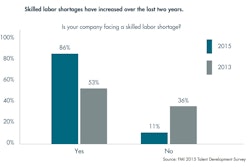The commercial construction sector in various parts of the U.S. is starting to wrap things up as temperatures plummet. With the winter months comes some needed breathing room to take stock of what worked and what didn’t over the past several months.
I suspect one topic of discussion will be the recent skilled worker shortages experienced across the country. If you found your business being caught short, you certainly weren’t alone.
It’s no secret the construction industry has struggled to attract and retain qualified workers. For some, it hindered the ability to bid on and/or complete certain jobs. The question is how to prevent such issues from happening again once construction starts to ramp up come next spring.
A reasonable starting point is to evaluate your existing workforce. Are the employees currently on staff sufficiently qualified for their roles, and are they living up to their full potential? If you know or suspect certain folks are working at less than full capacity or, on the flip side, have more to give and are being under utilized, now is the time to take action.
Implement measures during the slower months to encourage those who are under performing to step up their game. This can be as simple as a conversation to find out what makes them tick, or as formal as a disciplinary plan designed to wake them up to their lack of performance.
For personnel who may be under utilized, look into training opportunities to help them build the necessary skills to take on added responsibility and become even more valuable to your organization. This can include classroom training; cross training on other types of equipment; a mentorship program with more experienced field workers; a trade apprenticeship, etc. Consult with the worker to determine his or her interests, then explore ways to help them grow their value to your company.
Of course, your current workforce can only realistically do so much. But before bringing in additional staff, consider whether there are other ways to get the job done. Can certain tasks/functions be mechanized to reduce the number of people required and/or free up valuable employees for other tasks?
For example, rather than tying up multiple workers to dig a trench in a backyard, could a single operator and a compact excavator (purchased or rented) do the same job — and likely do it faster? Could adding a sweeper attachment to your inventory allow a skid steer to perform site cleanup in place of workers with brooms or a dedicated sweeper and another operator?
Another alternative is to subcontract out certain aspects of a project to allow your own personnel to focus on more critical or specialized tasks. There are numerous subcontractors out there who are willing to do almost anything to stay busy. Having a stable of reliable subs rather than more folks on the payroll could get the “grunt work” done, while reducing overall costs once you factor in health care and other benefits you may be required to provide to hired workers.
Have other suggestions for addressing the skilled worker shortage? Send them our way. I’d be happy to share them in this column.




















